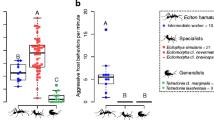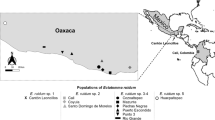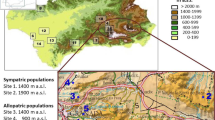Abstract
Cuticular hydrocarbon profiles are essential for nestmate recognition in insect societies, and quantitative variation in these recognition cues is both environmentally and genetically determined. Environmental cues are normally derived from food or nest material, but an exceptional situation may exist in the fungus-growing ants where the symbiotic fungus garden may be an independent source of recognition compounds. To investigate this hypothesis, we quantified the chemical profiles of the fungal symbionts of 18 sympatric colonies of Acromyrmex echinatior and Acromyrmex octospinosus and evaluated the quantitative variation of the 47 compounds in a multivariate analysis. Colony-specific chemical profiles of fungal symbionts were highly distinct and significantly different between the two ant species. We also estimated the relative genetic distances between the fungal symbionts using amplified fragment length polymorphism (AFLP) and correlated these with the overall (Mahalanobis) chemical distances between the colony-specific profiles. Despite the standardized laboratory conditions, the correlations were generally weak, but a statistically significant portion of the total variation in chemical profiles could be explained by genetic differences between the fungal symbionts. However, there was no significant effect of ant species in partial analyses because genetic differences between symbionts tend to coincide with being reared by different ant species. However, compound groups differed significantly with amides, aldehydes, and methyl esters contributing to the correlations, but acetates, alkanes, and formates being unrelated to genetic variation among symbionts. We show experimentally that workers that are previously exposed to and fed with the fungal symbiont of another colony are met with less aggression when they are later introduced into that colony. It appears, therefore, that fungus gardens are an independent and significant source of chemical compounds, potentially contributing a richer and more abundant blend of recognition cues to the colony “gestalt” than the innate chemical profile of the ants alone.



Similar content being viewed by others
References
Aitchison J (2003) The statistical analysis of compositional data, 2nd edn. Blackburn, Caldwell, New Jersey
Bass M, Cherrett JM (1994) The role of leaf-cutting ant workers (Hymenoptera: Formicidae) in the fungus garden maintenance. Ecol Entomol 19:215–220
Belt T (1874) The naturalist in Nicaragua. University of Chicago Press, Chicago
Bot ANM, Rehner SA, Boomsma JJ (2001) Partial incompatibility between ants and symbiotic fungi in two sympatric species of Acromyrmex leaf-cutting ants. Evolution 55:1980–1991
Bot ANM, Orthius-Lechner D, Finster K, Maile R, Boomsma JJ (2002) Variable sensitivity of fungi and bacteria to compounds produced by the metapleural glands of leaf-cutting ants. Insectes Soc 49:363–370
Breed MD (1998) Chemical cues in kin recognition: criteria for identification, experimental approaches, and the honey bee as an example. In: Vander Meer RK, Breed MD, Espelie KE, Winston ML (eds) Chemical communication in social insects. Westview, Boulder, Colorado, pp 57–78
Chapela IH, Rehner SA, Schultz TR, Mueller UG (1994) Evolutionary history of the symbiosis between fungus-growing ants and their fungi. Science 266:1691–1694
Cherrett JM, Powell RJ, Stradling DJ (1989) The mutualism between leaf-cutting ants and their fungi. In: Wilding N, Collins NM, Hammond PM, Webber JF (eds) Insect-fungus interactions. Academic, London, pp 93–116
Crozier RH, Dix MW (1979) Analysis of two genetic models for the innate components of colony odour in social Hymenoptera. Behav Ecol Sociobiol 4:217–224
Currie CR, Stuart AE (2001) Weeding and grooming of pathogens in agriculture by ants. Proc R Soc Lond B 268:1033–1039
Currie CR, Scott JA, Summerbell RC, Malloch D (1999) Fungus-growing ants use antibiotic bacteria to control garden parasites. Nature 398:701–704
Currie CR, Scott JA, Summerbell RC, Malloch D (2003) Corrigendum: Fungus-growing ants use antibiotic-producing bacteria to control garden parasites. Nature 423:461
Currie CR, Poulsen M, Mendenhall J, Boomsma JJ, Billen J (2006) Coevolved crypts and exocrine glands support mutualistic bacteria in fungus-growing ants. Science 311:81–83
Fénéron R, Jaisson P (1995) Ontogeny of nestmate brood recognition in a primitive ant, Ectatomma tubercalutum Olivier (Ponerinae). Anim Behav 50:9–14
Fletcher DJC, Michener CD (1987) Kin recognition in animals. Wiley, New York
Goudet J (1995) FSTAT (version 1.2): a computer program to calculate F-statistics. J Heredity 86:485–486, http://www.unil.ch/izea/softwares/fstat.html
Hall BG (2001) Phylogenetic analysis made easy: a how-to-do manual for molecular biologists. Sinauer Associates, Sunderland, Massachusetts
Heinze J, Foitzik S, Hippert A, Hölldobler B (1996) Apparent dear-enemy phenomenon and environment-based recognition cues in the ant Leptothorax nylanderi. Ethology 102:510–522
Hölldobler B, Wilson EO (1990) The ants. Harvard University Press, Cambridge
Jutsum AR, Saunders TS, Cherrett JM (1979) Intraspecific aggression in the leaf-cutting ant Acromyrmex octospinosus. Anim Behav 27:839–844
Lambardi D, Dani FR, Turillazzi S, Boomsma JJ (2007) Chemical mimicry in an incipient leaf-cutting ant social parasite. Behav Ecol Sociobiol 61:843–851, DOI 10.1007/s00265-006-0313-y
Lenoir A, Fresneau D, Errard C, Hefetz A (1999) Individuality and colonial identity in ants: the emergence of the social representation concept. In: Destrain C, Deneubourg JL, Pasteels JM (eds) Information processing in social insects. Birkhäuser, Berlin, pp 219–237
Littledyke M, Cherrett JM (1976) Direct ingestion of plant sap from cut leaves by the leaf-cutting ants Atta cephalotes (L.) and Acromyrmex octospinosus (Reich) (Formicidae, Attini). Bull Entomol Res 66:205–217
Mantel N (1967) The detection of disease clustering and a generalized regression approach. Cancer Res 27:209–220
Mehdiabadi NJ, Hughes B, Mueller UG (2006) Cooperation, conflict, and coevolution in the attine ant-fungus symbiosis. Behav Ecol 17:291–296
Möller A (1893) Die pilzgarten einiger südamerikanischer ameisen. Gustav Fisher, Jena
Mueller UG, Poulin J, Adams RMM (2004) Symbiont choice in a fungus-growing ant (Attini, Formicidae). Behav Ecol 15:357–364
Murakami T, Higashi S (1997) Social organization in two primitive attine ants, Cyphomyrmex rimosus and Myrmicocrypta ednaella, with reference to their fungus substrates and food sources. J Ethol 15:17–25
Nielsen J, Boomsma JJ, Oldham NJ, Petersen HC, Morgan ED (1999) Colony-level and season-specific variation in cuticular hydrocarbon profiles of individual workers in the ant Formica truncorum. Insectes Soc 46:58–65
North RD, Jackson CW, Howse PE (1997) Evolutionary aspects of ant-fungus interactions in leaf-cutting ants. Trends Ecol Evol 12:386–389
Ortius-Lechner D, Maile R, Morgan ED, Petersen HC, Boomsma JJ (2003) Lack of patriline-specific differences in chemical composition of the metapleural gland secretion in Acromyrmex octospinosus. Insectes Soc 50:113–119
Poulsen M, Boomsma JJ (2005) Mutualistic fungi control crop diversity in fungus-growing ants. Science 307:741–744
Quinlan RJ, Cherrett JM (1979) The role of fungus in the diet of the leaf-cutting ant Atta cephalotes (L.). Ecol Entomol 4:151–160
Richard FJ, Hefetz A, Christides JP, Errard C (2004) Food influence on colonial recognition and chemical signature between nestmates in the fungus-growing ant Acromyrmex subterraneus subterraneus. Chemoecology 14:9–16
Schneider M (2000) Observations on brood care behaviour of the leafcutting ant Atta sexdens L. (Hymenoptera: Formicidae). In: Abstracts of the XXI International Congress of Entomology, vol. 2 (August 20–26, 2000, Foz do Iguassu). Embraja Sojo, London, p 895
Schneider S, Roessli D, Excoffier L (2000) ARLEQUIN, ver. 2.000: software for population genetics data analysis. Genetics and Biometry Laboratory, University of Geneva, Switzerland,http://www.anthro.unige.ch/arlequin
Silverman J, Liang D (2001) Colony disassociation following diet partitioning in a unicolonial ant. Naturwissenschaften 88:73–77
Singer TL (1998) Roles of hydrocarbons in the recognition systems of insects. Am Zool 38:394–405
Soroker V, Vienne C, Hefetz A, Nowbahari E (1994) The postpharyngeal gland as a “Gestalt” organ for nestmate recognition in the ant Cataglyphis niger. Naturwissenschaften 81:510–513
Sumner S, Hughes WOH, Pedersen JS, Boomsma JJ (2004) Ant parasite queens revert to mating singly. Nature 428:35–36
Swofford DL (2002) PAUP*: phylogenetic analysis using parsimony (*and other methods), version 4.0b10. Sinauer Associates. Sunderland, Massachusetts
Vander Meer RK, Morel L (1998) Nestmate recognition in ants. In: Vander Meer RK, Breed M, Winston M, Espelie KE, Winston ML (eds) Pheromone communication in social insects. Westview, Boulder, Colorado, pp 79–103
Viana AMM, Frézard A, Malosse C, Della Lucia TMC, Errard C, Lenoir A (2001) Colonial recognition of fungus in the fungus growing ant Acromyrmex subterraneus subterraneus (Hymenoptera: Formicidae). Chemoecology 11:29–36
Vos P, Hogers R, Bleeker M, Reijans M, van de Lee T et al (1995) AFLP: a new technique for DNA fingerprinting. Nucleic Acid Res 23:4407–4414
Weber NA (1966) Fungus-growing ants. Science 153:587–604
Acknowledgements
We thank A.N.M. Bot, S. Rønhede, and S.M. Mathiasen for the assistance with fungus culturing and obtaining the AFLP data; J.S. Pedersen and G. Nachman for statistical advice; C.R. Currie for providing some of the experimental lab colonies; P. D’Ettorre for comments on the manuscript; the Smithsonian Tropical Research Institute (STRI) for providing logistic help and facilities to work in Gamboa; and the Autoridad Nacional del Ambiente y el Mar (ANAM) for the permission to sample ant colonies in Panama and export them to Denmark. Fieldwork was supported by grants from the Carlsberg foundation and the Danish Natural Science Research Council to JJB. All experiments performed in this manuscript comply with current Danish and USA laws.
Author information
Authors and Affiliations
Corresponding author
Additional information
Communicated by K. Ross
Freddie-Jeanne Richard and Michael Poulsen contributed equally to this work.
Rights and permissions
About this article
Cite this article
Richard, FJ., Poulsen, M., Hefetz, A. et al. The origin of the chemical profiles of fungal symbionts and their significance for nestmate recognition in Acromyrmex leaf-cutting ants. Behav Ecol Sociobiol 61, 1637–1649 (2007). https://doi.org/10.1007/s00265-007-0395-1
Received:
Revised:
Accepted:
Published:
Issue Date:
DOI: https://doi.org/10.1007/s00265-007-0395-1




